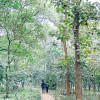Banglabazar: All things book
Walking past the Jagannath University and Dhaka Collegiate School, amid heavy noise of construction work at Dhaka Sadar Post Office, these correspondents heard a voice that cut through the cacophony in narrow lanes of Old Dhaka.
"What book do you need?"
Turning around, the correspondents noticed a man carrying a basket almost overflowing with books on his head, waiting for response.

Stationery shops on the right gave way to a bustling market, where a plethora of books, ranging from fiction to academic texts, available for purchase at remarkably affordable prices.
Leaving the stationery shops behind, the correspondents ventured into the market, gaining a unique vantage point of the narrow alleys.
Inside, the air was filled with the unmistakable scent of new books, reaffirming that they were indeed in the heart of Banglabazar, a haven for bibliophiles, where every dusty corner promises a world waiting to be discovered.
If it is a book that exists in Bangladesh, chances are one will surely find it here.

Peering outside, they witnessed porters carrying new books in woven baskets on their heads, skillfully navigating the narrow streets, while rickshaw-pullers honked their way through and motorcyclists maneuvered slowly, adapting to the confined space.
It's a pedestrian's kingdom; the narrow lanes and book stalls on every corner leave hardly any room for four-wheeled vehicles.
This is the story of Banglabazar, a place with nearly 200 publishing houses and 3,000 to 3,500 book shops.
BANGLABAZAR AND BOI MELA
There were books, lots of them -- on the shelves, on the floor -- every inch of a publisher's office is taken up by new books, while some more spill over to the warehouse.
Books are coming in on pick-ups, they are coming in on baskets, on rickshaw-vans, through the packed alleyways, as publishers are gearing ahead of the month-long Amar Ekushey Book Fair, which is set to begin in less than a week.
For the publishers, these few days before the book fair are demanding, while nights are outright hectic.
Osman Goni, a senior publisher and owner of Agami Prokashoni, shared, "In the past, as the fair approached, we would witness a surge in activity at Banglabazar. The dynamics have evolved over time, but even now, the place still transforms back to its old self."

Aditya Antor, publisher at Ittyadi Grantha Prakash, reminisced, "Banglabazar held a special place in my heart as a child. As a businessman in this industry, I still sense the same vibrancy after all these years."
Despite a decline in the publishing industry in recent times, it always becomes vibrant during preparations for the book fair, he added.
Wandering through the nooks and crannies of Banglabazar, it was seen that press workers and binders engaged in a hectic schedule. They said they were experiencing a period of immense pressure.
However, they also said it was still not much compared to the scene of the market a decade back, in the lead up to the book fair.
Faruk Hossain, owner of Swapno Binding, said, "The workload is considerably low this time. We used to hire 10-15 employees just for the Boi Mela, but this time we only hired four people. Honestly, Banglabazar has lost its charm."
Nurul Nabi, manager of Prottasha Auto Book Binding, echoed similar sentiments.

HOW BANGLBAZAR GOT ITS NAME
The origins of Banglabazar can be traced back to centuries ago, with the establishment of a settlement in Dhaka.
According to Dhaka dictionary of the Bangladesh Asiatic Society, the place used to be an emerging market at the time.
Hence, the name Banglabazar came into being as the word "bazar" means "market", say some historians.

Throughout its long history, Banglabazar has maintained its identity as a market, though the specific products it initially sold remain unclear.
The exact reason for naming it Banglabazar also remains a mystery, shrouded in the passage of time and historical ambiguity.
According to some, the name may be linked to the "Bangala Nagar" mentioned by ancient tourists, while others speculate on different origins for the distinctive title.
Notably, in 1506, Italian traveller Vertomannus described Banglabazar as the source of the world's finest silk and muslin, adding an intriguing historical dimension to this venerable market.
TRANSITION INTO BOOK MARKET
Banglabazar's love affair with books did not develop overnight. The development is intertwined with the city's history.
The narrative unfolds after the 1857 Sepoy mutiny, marking the establishment of the first bookstores that laid the foundation for Banglabazar's literary journey.

Printing presses in Babu Bazar played a pivotal role, connecting with selling points in Banglabazar.
The 20th century witnessed Banglabazar evolving into a vibrant literary hub, particularly with the establishment of Dhaka University in 1921, attracting writers and intellectuals who engaged in lively debates within its confines.

RISE TO FAME
It was in 1925 that Banglabazar witnessed a significant literary milestone with the publication of Buddhadeb Basu's "Marmabani", the first book of poems to be published in this historic market.
The partition in 1947 brought a transformation to Banglabazar. While Calcutta (now Kolkata) was already a publishing hub on the other side of the border, Banglabazar became a fertile ground for homegrown writers of the then East Pakistan.
Publishers like Nawroz Kitabistan, Student Ways, and Great East Library emerged as integral names synonymous with Banglabazar, their storefronts lined up along the winding alleys like chapters in a grand narrative.

Notably, during that period, Mollik Brothers of Calcutta established a branch in Banglabazar, attracting many others who found their address in this market.
Several Banglabazar publishers were also writers themselves, such as Mohammad Nasir Ali (founder of Nawroz), Borkat Ullah, and poet Mainuddin.
The 1960s marked a significant shift as textbook publishing became prominent, solidifying Banglabazar's reputation. The establishment of the East Pakistan Textbook Board shifted the market's focus towards education, but the essence of creativity inherent in the market never truly faded away.
Even after the rise of multi-storey markets, the narrow alleys of Banglabazar retained their cultural essence, resonating with the whispers of poetry, philosophical debates, and the influx of religious and educational discourse.

Starting from 1965, Iftekhar Rasool George, owner of Nawroze Sahitya Sambhar, has been a regular visitor to Banglabazar.
"There was a time when most shops were single-storey and buildings didn't exceed the second floor," he said. During this period, houses were constructed with tin roofs or built using lime, mud, and rubble.
The post-1971 era marked the introduction of buildings made with rods and cement in Banglabazar.
According to George, back then, all the shops were situated on the main road, from where one could catch a glimpse of the Buriganga river.
Since independence, Monirul Haque, owner of Ananya Prakashani, has been a familiar face in Banglabazar, witnessing its transformation.
"The Banglabazar we see today differs significantly from the past, where publishing houses operated from small shops in modest buildings," he said.
Publishing houses such as Punthighor, Khan Brothers, Boighar, Nawroz, Book Society, and Student Way began their operations in Banglabazar, he said.
During that era, establishments like Ananya, Anupom, Agamir, and Mawla Brothers also contributed to the vibrant atmosphere, with renowned writers engaging in book discussions and enjoying tea at nearby Beauty Boarding.
However, the landscape has transformed over time, particularly since the government started providing free textbooks. Before that, people from all over the country would come here. It was difficult to walk through the crowds, said Monirul.

PUBLISHING HOUSES CLOSING SHOP
Due to the lack of book sales and the rising cost of raw materials, many publishing houses have been forced to close incurring losses.
These include Jupiter, Globe, Adil, and Galaxy.
One veteran publisher from Banglabazar shared that the publishing industry employs around 30 lakh people across the country.
PRINTING INDUSTRY IN CRISIS
General secretary of Bangladesh Printing Industry Association, Zahurul Islam, said the main reason behind the rising costs is the price hike of paper and raw materials. "To cut production costs, we even reduce the font size nowadays," he added.
Shyamal Pal, the association's vice-president, said due to the new curriculum changes, students are also not buying that many guidebooks.
"The price of paper is extremely high. We had requested the government to limit the import duty on paper by December-January, but this has not been done. Considering all the facts, the business is decaying slowly," he added.


 For all latest news, follow The Daily Star's Google News channel.
For all latest news, follow The Daily Star's Google News channel. 


Comments